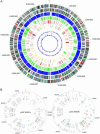The complete genome sequence of the Arabidopsis and tomato pathogen Pseudomonas syringae pv. tomato DC3000
- PMID: 12928499
- PMCID: PMC193536
- DOI: 10.1073/pnas.1731982100
The complete genome sequence of the Arabidopsis and tomato pathogen Pseudomonas syringae pv. tomato DC3000
Abstract
We report the complete genome sequence of the model bacterial pathogen Pseudomonas syringae pathovar tomato DC3000 (DC3000), which is pathogenic on tomato and Arabidopsis thaliana. The DC3000 genome (6.5 megabases) contains a circular chromosome and two plasmids, which collectively encode 5,763 ORFs. We identified 298 established and putative virulence genes, including several clusters of genes encoding 31 confirmed and 19 predicted type III secretion system effector proteins. Many of the virulence genes were members of paralogous families and also were proximal to mobile elements, which collectively comprise 7% of the DC3000 genome. The bacterium possesses a large repertoire of transporters for the acquisition of nutrients, particularly sugars, as well as genes implicated in attachment to plant surfaces. Over 12% of the genes are dedicated to regulation, which may reflect the need for rapid adaptation to the diverse environments encountered during epiphytic growth and pathogenesis. Comparative analyses confirmed a high degree of similarity with two sequenced pseudomonads, Pseudomonas putida and Pseudomonas aeruginosa, yet revealed 1,159 genes unique to DC3000, of which 811 lack a known function.
Figures



References
Publication types
MeSH terms
Substances
Associated data
- Actions
- Actions
- Actions
Grants and funding
LinkOut - more resources
Full Text Sources
Other Literature Sources
Molecular Biology Databases

